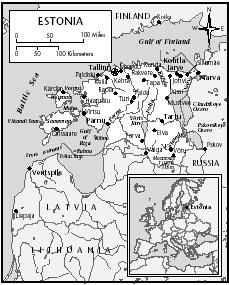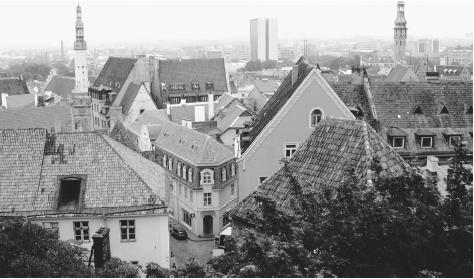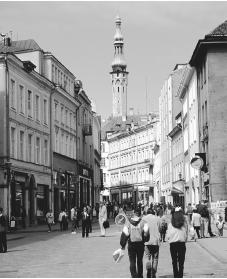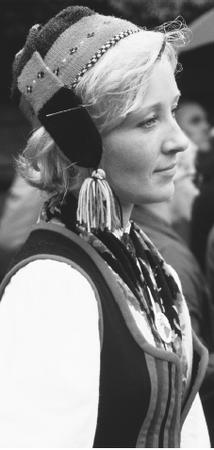Estonia
Culture Name
Estonian
Alternative Names
Republic of Estonia; Estonians refer to themselves as eestlased and to the country as Eesti or Eesti Vabariik.
Orientation
Identification. "Eesti" can be traced to a first-century mention by the Roman historian Tacitus of a people or place called Aestii or Aestui. The name may derive from a German word referring to the east. Place names have been traced to this period, suggesting a link between language and homeland. The first written evidence of Estonian is in the Chronican Livoniae (1180–1227), which includes descriptions of the society and a selection of words and phrases.
Estonians have strong connections to local traditions related primarily to different dialects and reinforced by variations in customs and dress. Islands, including Saaremaa, have their own traditions, and people speak distinctive dialects. Other local cultures with different dialects include the mulgid (in southern Viljandimaa), the vorukad (from Voru), and the setud (from Setumaa, currently divided by the border between Estonia and Russia). Despite local attachments, people feel that they share a common culture. The country has a sizable community of ethnic Russians whose connections to Estonia have begun to develop only recently.
Location and Geography. The country is bordered to the west and north by the Baltic Sea, with Lake Peipsi forming a border with Russia to the east. Most of the country is at or near sea level. The lowest areas, encompassing the islands, western Estonia, and the northern coast and extending along Lake Peipsi, traditionally have been associated with maritime trade and fishing.
A single state is of recent origin. Estonia was divided into two provinces—Estland to the north and Livland (including part of modern Latvia) to the south—during Polish-Swedish rule from the 1560s to 1710 and later under imperial Russia.
Demography. In 1999, the population was about 1.45 million. Estonians account for 65 percent of the population, Russians 28 percent, and Ukrainians 2 percent. Before World War II, the population was about 88 percent Estonian. After the war, the percentage of Estonians steadily declined, reaching a low of 61 percent in 1989, with the Russian population increasing to 30 percent. The percentage of Estonians has increased since that time. Approximately fifty thousand Estonians live in the former Soviet Union, and another fifty thousand to seventy thousand reside in North America, Europe, and Australia.
Linguistic Affiliation. Estonian belongs to the Finno-Ugric linguistic group, related closely to Finnish and more distantly to Hungarian and various languages spoken in Siberia. Speakers of the language probably arrived in the region between 2000 and 3000 B.C.E. Until the nineteenth century, Estonian was spoken by the peasantry, and thus it is central to the national identity. Until the nation regained independence, Estonians were more likely than Russians to speak both Estonian and Russian. This is changing as citizenship and job opportunities push Russians toward learning Estonian. English is gaining popularity as a second or third language.
Symbolism. There is a strong attachment to the mother tongue ( emakeel ) and the fatherland ( isamaa ). The metaphor of the family is common, with a sense of belonging reinforced by a shared understanding of history and roots in rural, peasant values. These values connect Estonians to nature. The cornflower and the barn swallow are common national symbols, and stone and wood have an organic meaning for peasants struggling against nature. The national struggle against foreign occupation is an extension of this historical fight for survival. The most important political symbols are the horizontally striped blue, black, and white flag, symbolizing sky, earth, and virtue and hope, and the coat of arms featuring three lions. The flag represents the nation, and its presence atop the Tall Hermann tower in Tallinn, the capital, represents national and cultural independence.
History and Ethnic Relations
Emergence of the Nation. Estonia was ruled by Poles, Danes, Germans, Swedes, and Russians after the thirteenth century. Before the nineteenth century, the national identity was synonymous with the peasantry. The local nobility and clergy, merchants, and traders were predominantly Baltic Germans; an Estonian could enter the upper classes only by adopting the German language and German customs. Estonians referred to themselves as maarahvas ("country folk") and to a Baltic German as a saks (short for "German"). The first term showed a connection to a place, while saks was used to refer to anyone with high status.
The development of a written language was important to cultural awareness. The first Estonian book was printed in 1535, and a Bible was published in 1739. Education in Estonian was a key part of national development. In addition to the peasant tradition of teaching children to read at home, an elementary education system was organized in the 1680s. By 1850, approximately 90 percent of the population was literate.
From 1802 to 1856, the peasantry was emancipated and granted limited property rights. Although these reforms had little effect, they limited the power of Baltic Germans and began to separate ethnic identity from economic status. Under Tsar Nikolai I, Russification policies were introduced to assimilate non-Russian populations into the empire. Under these policies, approximately 17 percent of Estonians were converted to the Russian Orthodox religion. Apart from the actual number of conversions, the policy suggested a cultural basis for challenging the domination of the Baltic Germans, who used religion to justify the socioeconomic status quo.
The middle of the nineteenth century marked the beginning of the national awakening. A small group of intellectuals played a vital role in giving the traditional culture a national meaning. In 1857,

Other aspects of culture were adapted from earlier usages and made "more Estonian" as older traditions such as the wearing of folk clothing and singing in the traditional style declined. The first song festival was organized by Jannsen in 1869. Capitalizing on the popularity of church choirs, the festival became the most popular national tradition, although the first one was modest in size and included only two Estonian authors. Poetry, long part of the national song tradition, emerged as a literary form, with Lydia Koidula (Jannsen's daughter) the best loved poet.
In an attempt to undermine the power of the Baltic Germans, Russification was reintroduced by Alexander II and Alexander III. Orders to use Russian in schools had the unintended effect of uniting Estonians against what they saw as an attack on their culture.
By the late 1800s, an Estonian identity had been established and efforts were being made to retrieve the "original culture" by collecting folk poems, sayings, and songs. This process became a national project, pushed originally by Hurt but largely dependent on newspapers. The work later expanded to include folk art and crafts and led to the creation of a national museum in 1908.
Nationalism has continued to evolve. After the Soviet Union occupied the country during World War II, cultural expression was subject to censorship and the use of symbols associated with independence (the flag) was banned.
Estonia was politically independent between 1918 and 1940, and became independent again in 1991. Nationalism survived by adapting forms of expression that could not be controlled by the Soviet authorities. Poetry, music, and film commented on political oppression in ways that only Estonians could understand. The influence of nationalism was reflected in the fact that 250,000 people took part in the 1969 song festival.
National Identity. In both the 1880s and the 1980s, national identity solidified in reaction to Russification policies imposed by the government. The "Letter of Forty," signed by forty well-known artists and intellectuals in 1980, raised concerns about the cultural effects of Russification, setting the stage for the New Awakening in 1987 and 1988.
Ethnic Relations. During the Soviet occupation, policies encouraging the immigration of Russians to Estonia reduced the percentage of ethnic Estonians. The immigrants were seen as occupiers and colonists, and relations between Estonians and Russians are still strained.
Urbanism, Architecture, and the Use of Space
Although built under foreign rule, buildings are important symbols. City walls, towers, churches, and fortresses strongly connect Estonians to the past. Though few unaltered examples remain, the design of an old Estonian farmhouse is considered part of the national culture. The timbered house is long and low, with a relatively low-pitched thatched roof. Farm buildings are often arranged around a central yard area. There are regional variations in fencing, including wood fences (made of sticks or twigs) and low stone walls (mostly in coastal areas). Windmills are part of a remembered past, but only a handful remain for tourist purposes.
Food and Economy
Food in Daily Life. In the fall and winter, soups and stews predominate, with potatoes a staple at most meals. In the spring and summer, fresh tomatoes and cucumbers accompany every meal. Sandwiches are common breakfast fare, and coffee is drunk frequently throughout the day and at social events. In coastal areas, fish is eaten. Many people grow fruits, vegetables, and berries during the summer and can what remains in the fall. Family dinners are infrequent, as both parents usually work. Most families try to share one meal together on the weekend.
Food Customs at Ceremonial Occasions. Christmas dinner includes roast pork or goose, blood sausage, sauerkraut, potatoes, and head cheese, with gingerbread cookies for dessert. Other special occasions such as birthdays, weddings, and funerals do not require special foods, though it is expected that food will be plentiful. Evening social gatherings almost always include meals accompanied by vodka.
Basic Economy. Although the culture emphasizes self-sufficiency, this is no longer possible as Estonia becomes integrated into the global economy. Local production, including agriculture, is augmented by imports, primarily from the European Union. Only 11 percent of the labor force is employed in agriculture and forestry. While these residents may produce enough to be self-sufficient, most citizens are urbanized and purchase food and other necessities.
Land Tenure and Property. The privatization of property once controlled by the Soviet state continues. Not all property can be directly returned to the original owners. Owners are given vouchers for the value of the property that can be exchanged for other property or stock options.
Commercial Activities. In addition to goods for export, the economy is oriented toward food production, clothing, and manufactured goods, especially the production of spare parts for machinery, appliances, and automobiles. A large amount of

Major Industries. Light manufacturing and textiles are important for both foreign and domestic markets. Oil shale is mined and used primarily to produce electricity.
Trade. Exports include machinery, parts, and electrical equipment (20 percent of exports in 1998), timber and wood products, textiles, and clothing. The main export markets are Finland, Sweden, and Russia. Imports include machinery and appliances (26 percent), foodstuffs (15 percent), chemical products (10 percent), metals (9 percent), and textiles (8 percent). The primary source of imports is Finland, followed by Russia, Sweden, and Germany.
Division of Labor. In the transition to a market economy, nearly all jobs give priority to younger workers. Education affords status to any employee even if his or her background is in a different field. Privatization has brought back family farms, but they are unlikely to survive the transition to membership in the European Union. Heavy industry and factory jobs have been cut, leaving many Russian workers unemployed.
Social Stratification
Classes and Caste. The top 20 percent of the population earns 40 percent of the total income, while the bottom 20 percent earns only 2 percent. Inequality has increased dramatically since 1991, but the trend has slowed since 1996.
Symbols of Social Stratification. The nouveau riche engage in many forms of conspicuous consumption, including expensive cars, cellular phones, designer clothing, and the display of trophy wives and mistresses.
Political Life
Government. In a parliamentary democracy with a state assembly ( Riigikogu ) of 101 members, the government is headed by a prime minister. The president is the ceremonial head of state and is elected by the assembly.
Leadership and Political Officials. Candidates for political office usually are drawn from a relatively small circle. Officials who leave office frequently work in prominent positions in government or private business. The current political parties are the Pro Patria Union, the Centrist Party,

Social Problems and Control. The police operate at the national level. There is a three-tiered legal system: city and county and administrative courts, which hear criminal, civil, and investigative cases; appellate circuit courts; and a supreme court, which hears appeals and constitutional cases. The police and judicial systems are perceived as corrupt and are not trusted. People try to avoid any situation in which the authorities may get involved. Theft and burglary are overwhelmingly the largest crime problems.
Military Activity. Men serve one year in the military. Military service is unpopular and carries little prestige. There is an army, a navy, and a limited air defense system, as well as an internal security force, which is primarily the border patrol. Combined, there are about 4,500 people in the armed services. In addition, the Defense League ( Kaitseliit ) has about 6,000 volunteer members.
Social Welfare and Change Programs
There are limited unemployment benefits, and the elderly receive social security payments. Pensioners consider their benefits inadequate.
Nongovernmental Organizations and Other Associations
There are more than 5,700 civic groups and organizations, along with 3,145 nonprofit organizations. Most have organized only recently and are understaffed and poorly funded.
Gender Roles and Statuses
Division of Labor by Gender. Young women are given jobs in the most visible positions in the service sector, such as retail sales, bank tellers, and secretarial work. Men are almost always preferred for executive positions because they are considered more dependable and less emotional. Although there are some women in politics, they are under-represented in the government.
The Relative Status of Women and Men. Women are expected to defer to men even when male views are seen as wrong or incorrect. However, women's rights are legally protected by the Constitution, which explicitly forbids gender discrimination.
Marriage, Family, and Kinship
Marriage. There are no formal or informal restrictions on marriage. Marriage to non-Estonians, especially Russians, is not welcomed but is not forbidden. It is estimated that more than half of all marriages end in divorce.
Domestic Unit. The family includes a husband, a wife, and an average of one child. It is not unusual for an elderly parent to live with the family. Both parents are likely to work, but the wife is responsible for household chores. Whether living in the household or separately, grandparents often help with child care.
Inheritance. Private and personal property can be inherited, usually by the children of the deceased.
Socialization
Infant Care. Very small children usually do not leave the home but are taken for walks to get fresh air, which is considered healthy. Crying babies are picked up and calmed by their parents.
Child Rearing and Education. Children are allowed to explore and play on their own. Education is highly valued, and a child is expected to learn how to read, write, and do simple math at home.
Higher Education. A university education is prized and confers a high status.
Etiquette
Estonians are socially introverted and maintain a distance in public and private spaces. People move relatively quickly, seldom make eye contact, and talk in hushed tones in public. Russians are perceived as being loud, boisterous, and not respectful of personal space.
Religion
Religious Beliefs. The Evangelical Lutheran Church is the largest denomination, with about 185,000 members. There is a dispute between the Estonian Apostolic Orthodox Church (EAOC) and the Russian Orthodox Church; more ethnic Estonians belong to the EAOC, which has approximately three thousand members. Other churches have small but growing congregations. Most people attend church only at Christmas and do not consider themselves religious, although they believe in an afterlife and have some concept of fate. Astrology, supernatural beliefs, and shamanism (from the country's pre-Christian roots) have gained acceptance.
Medicine and Health Care
Doctors and modern medicine are beginning to be trusted. For common illnesses, people rely on traditional home remedies.
Secular Celebrations
Traditional weddings are two- or three-day events that include games and generous amounts of food and drink. Birthdays are always celebrated, and christenings and confirmations are celebrated with large parties. The most important holiday remains Christmas. Despite Soviet opposition, Christmas trees were decorated and traditional foods were served. New Year's Eve is considered part of the Christmas holidays. A sauna before midnight cleanses the body and spirit for the upcoming year.
The old folk calender included many days that influenced farming decisions. On Shrove Tuesday, people still go sledding to make flax plants grow taller. On Saint John's Eve (23 June), nearly all Estonians go to the countryside to celebrate midsummer with large bonfires. Saint Martin's Day (10 November) and Saint Catherine's Day (25 November) are celebrated with children dressing up

State holidays with official governmental celebrations include Independence Day (24 February), Victory Day (23 June), and Independence Restoration Day (20 August).
The Arts and Humanities
Support for the Arts. Formerly state-subsidized, artists are now self-supporting.
Literature. Nationalism has depended on writing, and Estonians self-identify themselves in fictional works. Early novels mirrored rural hardships in distinctively Estonian settings. In the 1960s, writers began to comment on the lack of cultural and political freedom. Jaan Kross reinvented Estonian cultural heroes in his historical novels.
Graphic Arts. Applied arts, including pottery, ceramics, and textiles, often incorporate national motifs.
Performance Arts. Drama, ballet, and opera have been popular since the nineteenth century. Estonian classical music has gained global recognition through the composers Arvo Pärt, Veljo Tormis, and Eduard Tubin and the conductors Eri Klas and Neeme Järvi.
The State of the Physical and Social Sciences
Funding comes from international sources, and research frequently is completed in other countries. The study of genetic diseases and gene therapy has been established. Tartu University is known for work in linguistics and semiotics.
Bibliography
Kaskla, Edgar. "Estonian Nationalism in Comparative Perspective." Ph.D. dissertation, University of California, Irvine, 1992.
Loit, Alexander, ed. National Movements in the Baltic Countries, 1985.
Misiunas, Romuald J. and Rein Taagepera. The Baltic States: Years of Dependence, 1940–1980, 1983.
Nirk, Endel. Estonian Literature, 1987.
Rauch, George von. The Baltic States: The Years of Independence, 1917–1940, 1974.
Raun, Toivo U. Estonia and the Estonians, 1987.
Taagepera, Rein. Estonia: Return to Independence, 1993.
Tedre, Ülo, ed. Estonian Customs and Traditions, 1995.
Web Sites
Estonian Institute. "Estonian Information Page by Estonian Institute," http://www.einst.ee
—E DGAR K ASKLA
~Kasia
Actually, the reason, why I stumbled to this article was that I wanted to understand other cultures by comparing their text and view about one culture that I know well, with my own view. So, in that regard, finding an article that I agree with that much is a failure. I'm actually looking for views by foreigners that I do not come up with myself.
-the police and judicial system are not seen as corrupt anymore, the situation has improved dramatically since the early 90s.
-the social benefits have much room for improvement but some benefits, such as the financial support to mothers, are quite good
-women are not expected to defer to men in all aspects; in fact, Estonian women are far better educated than the Estonian men (70% of students in higher education are female) and generally economically and socially independent, although a gender-based pay gap remains
Im doing a sociology video on Estonia culture. We are learning about Culture Switches, and I wanted to personally ask what the differences you find in your culture from America is!
I am sorry to bother you, I hope you have a wonderful day!
- Hailee Rice, Coventry High School
-Megan Collins, University of North Georgia
-CDT Scheff, Yegor
Georgia Military College